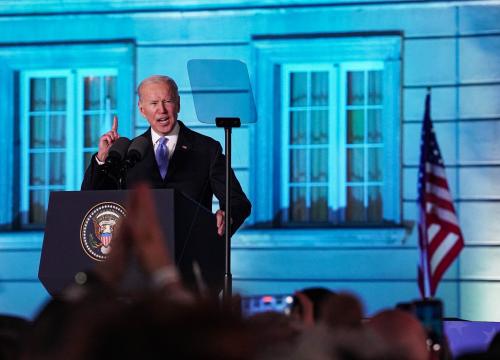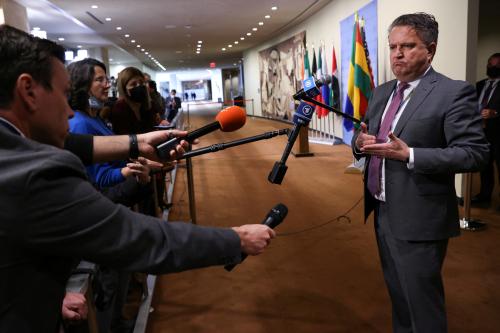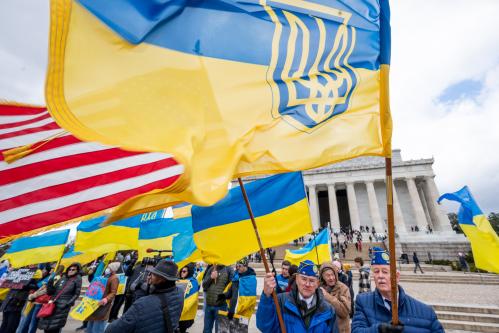Previous versions of this article incorrectly referred to Nielsen by the previous name of the entity, “Nielsen Scarborough.”
In May, a University of Maryland Critical Issues Poll found a drop in the American public’s expressed preparedness to pay a price for supporting Ukraine in its war with Russia, compared to the levels expressed in March, on three dimensions: increased energy costs, rising inflation, and preparedness to pay a price in American lives. The latest edition of the Critical Issues Poll, which I lead with Professor Stella Rouse, finds that the drop in May has not become a trend — and in fact the expressed public preparedness to pay a price has increased slightly since May, though it remains lower than it was in March. The poll of 2,208 respondents was fielded by Nielsen June 22-28, with a margin of error of +/- 2.09%. The finding is especially notable given the increase in oil prices and rising inflation that Americans have endured since the start of the war — and should be music to President Joe Biden’s ears as his administration has invested heavily in backing Ukraine, strengthening and expanding the North Atlantic Treaty Organization (NATO), and confronting Russia. Here are four key findings from the latest poll:
1
Americans are still prepared to support Ukraine even if this means higher energy costs and increased inflation, with an uptick from May, but below the level of support expressed in March. In the June poll, 62% of respondents said they were prepared to endure higher energy costs, up from 59% in May but down from 73% in March. Similarly, 58% expressed preparedness for increased inflation, up from 52% in May but down from 65% in March. Americans’ preparedness for the loss of U.S. troops remains low at 32% but rose back to March levels after a dip in May.

2
There are substantial differences in the degree of preparedness to pay a price for supporting Ukraine between Democrats and Republicans, and the gap between the two is slowly growing, with Democrats expressing much greater willingness to pay a price. While 78% percent of Democrats are prepared to see higher energy costs, only 44% of Republicans say the same; while 72% of Democrats are prepared to pay with higher inflation, only 39% of Republicans say the same.
The gap in preparedness to pay higher energy prices between Democrats and Republicans has grown from 30 percentage points in March to 32 points in May to 34 in June. Similarly, on preparedness to see increased inflation, the gap has grown from 28 percentage point in March to 31 points in May to 34 in June. On preparedness for loss of U.S. troops, the gap between Democrats and Republicans grew in June from 5 percentage points in March to 9 in May to 15 in June. Among Republicans, 22% are prepared to risk American soldiers’ lives compared to 37% of Democrats.
3
While a plurality of respondents says that both Russia and Ukraine are neither succeeding nor failing in their war efforts (37% and 40% respectively), they see Ukraine as more succeeding than failing (27% to 20%), while they see Russia as more failing than succeeding (29% to 20%). This holds for both Democrats and Republicans.

4
Even though the Biden administration has opposed imposing a no-fly zone (NFZ) over Ukraine, there is a growing public support for doing so, despite the concern about confrontation with Russia. Support for NFZ grew from 56% in March to 59% in May and 65% June. This trend transcended party lines, with a growing number of Republicans (52% to 54% to 57%) and Democrats (61% to 64% to 72%) supporting enforcing a NFZ should the war persist. As we noted in our article in May, an experiment we conducted in the May poll showed that respondents are more reluctant to impose a NFZ when informed of the potential direct conflict with Russia inherent in the act, but are more supportive when there is no mention of a direct connection. The trend could be a result of the public not making a direct connection to confrontation with Russia, possibly coupled with public wish for more decisive NATO support for Ukraine.

Conclusions
The findings suggest that the drop in American public preparedness to pay a price for supporting Ukraine and confronting Russia has not become a trend; in fact, there is a slight uptick in the expressed preparedness to pay a price, compared to a month earlier, though slightly lower preparedness to pay a price than in March. This is good news for the Biden administration which has prioritized support for Ukraine. If fatigue grows, it would be music to Russian President Vladimir Putin’s ears. Aside from the heavy price Ukrainians are paying for the war fought on their territory, the Russian people are paying the second-highest cost — much more than the cost born by Americans in their support role for Ukraine. But Putin could count on this if American fatigue grows: Over time, public fatigue in democracies is more likely to be politically consequential than in autocracies, as leaders in democracies tend to be more sensitive to the attitudes of their publics.
It is also notable that few Americans see Russia as winning the war, something that almost always affects the calculus for staying the course. Our poll finds that respondents who say Russia is failing are more likely to be prepared to pay a price for supporting Ukraine than those who say Russia is succeeding.
The Brookings Institution is committed to quality, independence, and impact.
We are supported by a diverse array of funders. In line with our values and policies, each Brookings publication represents the sole views of its author(s).








Commentary
Americans’ preparedness to pay a price for supporting Ukraine remains robust
July 5, 2022